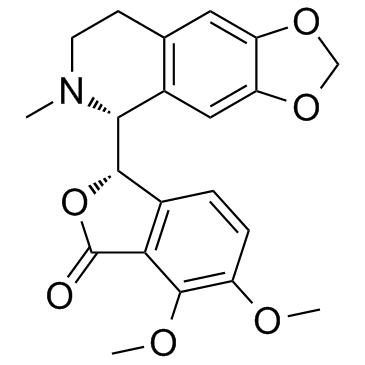Hydrastine (beta-Hydrastine; l-Hydrastine) is a natural alkaloid present in Hydrastis canadensis and other plants of the ranunculaceae family. It is one of the primary active ingredients in many dietary supplements meant to strengthen the immune system, made from the medicinal plant Hydrastis canadensis.
Physicochemical Properties
| Molecular Formula | C21H21NO6 |
| Molecular Weight | 383.4 |
| Exact Mass | 383.137 |
| Elemental Analysis | C, 65.79; H, 5.52; N, 3.65; O, 25.04 |
| CAS # | 118-08-1 |
| Related CAS # | 118-08-1 |
| PubChem CID | 197835 |
| Appearance | White to light yellow solid powder |
| Density | 1.339g/cm3 |
| Boiling Point | 548.8ºC at 760mmHg |
| Melting Point | 132ºC |
| Flash Point | 285.7ºC |
| Vapour Pressure | 4.28E-12mmHg at 25°C |
| Index of Refraction | 1.614 |
| LogP | 2.811 |
| Hydrogen Bond Donor Count | 0 |
| Hydrogen Bond Acceptor Count | 7 |
| Rotatable Bond Count | 3 |
| Heavy Atom Count | 28 |
| Complexity | 601 |
| Defined Atom Stereocenter Count | 2 |
| SMILES | O=C1O[C@H]([C@@H]2N(C)CCC3=C2C=C(OCO4)C4=C3)C5=C1C(OC)=C(OC)C=C5 |
| InChi Key | JZUTXVTYJDCMDU-MOPGFXCFSA-N |
| InChi Code | InChI=1S/C21H21NO6/c1-22-7-6-11-8-15-16(27-10-26-15)9-13(11)18(22)19-12-4-5-14(24-2)20(25-3)17(12)21(23)28-19/h4-5,8-9,18-19H,6-7,10H2,1-3H3/t18-,19+/m1/s1 |
| Chemical Name | (3S)-6,7-dimethoxy-3-[(5R)-6-methyl-7,8-dihydro-5H-[1,3]dioxolo[4,5-g]isoquinolin-5-yl]-3H-2-benzofuran-1-one |
| Synonyms | (-)-beta-Hydrastine; l-Hydrastine; beta-Hydrastine; Hydrastine |
| HS Tariff Code | 2934.99.03.00 |
| Storage |
Powder-20°C 3 years 4°C 2 years In solvent -80°C 6 months -20°C 1 month |
| Shipping Condition | Room temperature (This product is stable at ambient temperature for a few days during ordinary shipping and time spent in Customs) |
Biological Activity
| Targets | PAK4 |
| References |
[1]. Oncol Rep . 2016 Apr;35(4):2246-56. |
| Additional Infomation |
Hydrastine is a member of isoquinolines. It has a role as a metabolite. Hydrastine has been reported in Hydrastis canadensis, Berberis aquifolium, and other organisms with data available. See also: Goldenseal (part of). |
Solubility Data
| Solubility (In Vitro) | DMSO: 77~100 mg/mL (200.8~260.8 mM) |
| Solubility (In Vivo) |
Solubility in Formulation 1: ≥ 2.5 mg/mL (6.52 mM) (saturation unknown) in 10% DMSO + 40% PEG300 + 5% Tween80 + 45% Saline (add these co-solvents sequentially from left to right, and one by one), clear solution. For example, if 1 mL of working solution is to be prepared, you can add 100 μL of 25.0 mg/mL clear DMSO stock solution to 400 μL PEG300 and mix evenly; then add 50 μL Tween-80 to the above solution and mix evenly; then add 450 μL normal saline to adjust the volume to 1 mL. Preparation of saline: Dissolve 0.9 g of sodium chloride in 100 mL ddH₂ O to obtain a clear solution. Solubility in Formulation 2: ≥ 2.5 mg/mL (6.52 mM) (saturation unknown) in 10% DMSO + 90% (20% SBE-β-CD in Saline) (add these co-solvents sequentially from left to right, and one by one), clear solution. For example, if 1 mL of working solution is to be prepared, you can add 100 μL of 25.0 mg/mL clear DMSO stock solution to 900 μL of 20% SBE-β-CD physiological saline solution and mix evenly. Preparation of 20% SBE-β-CD in Saline (4°C,1 week): Dissolve 2 g SBE-β-CD in 10 mL saline to obtain a clear solution. Solubility in Formulation 3: ≥ 2.5 mg/mL (6.52 mM) (saturation unknown) in 10% DMSO + 90% Corn Oil (add these co-solvents sequentially from left to right, and one by one), clear solution. For example, if 1 mL of working solution is to be prepared, you can add 100 μL of 25.0 mg/mL clear DMSO stock solution to 900 μL of corn oil and mix evenly. (Please use freshly prepared in vivo formulations for optimal results.) |
| Preparing Stock Solutions | 1 mg | 5 mg | 10 mg | |
| 1 mM | 2.6082 mL | 13.0412 mL | 26.0824 mL | |
| 5 mM | 0.5216 mL | 2.6082 mL | 5.2165 mL | |
| 10 mM | 0.2608 mL | 1.3041 mL | 2.6082 mL |
